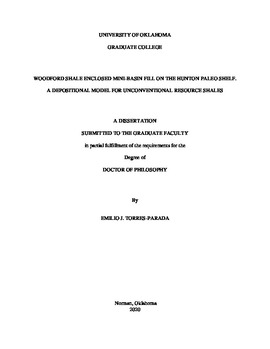| dc.description.abstract | The exploration of unconventional hydrocarbon resources of the Woodford Shale in Oklahoma (USA) has focused on characterizing this formation as an entirely open marine deposit. The impact of recognizing the enclosed mini-basin fill settings remains under-explored. To better understand these effects, I propose a detailed integrated study to highlight how these depositional variations occur. It is necessary to perform a workflow that involves multidisciplinary integration of geological, geochemical (both organic and inorganic) and geophysical characterizations to identify the characteristics of these deposits, how they vary vertically in the stratigraphic section of the Woodford Shale (internal variations in organic matter content and type; variability of the major heavy elements; and differences in mineralogy), and how they are laterally dissimilar by analyzing and comparing different Woodford locations in the Oklahoman petroleum provinces.
The enclosed mini-basin fill settings occur locally in areas of thicker (gross thickness greater than 200 ft) and more organic-rich Woodford Shale (greater than 5.5 % on average of total organic carbon TOC). By understanding the context of regional sea-level fluctuations in the Upper Devonian time, it is observed that the Woodford Shale is deposited upon a pre-existent carbonate platform, where this platform was previously eroded by karstification or incised valley development during regional sea level drops at the pre-Woodford time. These karst/incised valley-forming processes formed a regional erosional unconformity, which allowed the development of sinkholes, pockets, and pods with more accommodation space for Woodford Shale sediment deposition in enclosed mini-basin fill settings. These erosional unconformities can be identified in outcrops, cores, well logs, and on 3D seismic data sets. I propose that the localized and discontinuous enclosed mini-basin fills settings represented silled constricted oceanic circulation with higher bottom-water euxinia (high free sulfur), which had better conditions for accumulation and preservation of clay and organic matter particles than did the well-circulated, open marine settings. I interpret that these depositional differences provide recognizable patterns in bed thickness and organic matter variations inside the Woodford Shale. I propose that areas in Oklahoma with thicker Woodford enclosed mini-basin fill settings are stratigraphical variations that could economically produce more oil and gas than other areas deposited under more open marine conditions or thinner enclosed mini-basin fill intervals.
I capture these intervals by determining which ones contain more organic matter, more hydrogen, lower oxygen, more amorphous organic matter (more oil-prone than gas prone), the differences in paleo water chemistry (water column stratification, higher water salinity, higher levels of anoxia and euxinia). I recognize that these enclosed mini-basin fill geochemical characteristics are combined with the identification of enrichments in detrital quartz and relatively high depletions in the clay content of the lithofacies. The enclosed mini-basin fill deposits not only accumulate more organic matter but present different petrophysical and mechanical characteristics that, when modeled, simulated and compared with reported production, recover higher volumes of hydrocarbons under the standard unconventional petroleum industry operational practices. | en_US |
